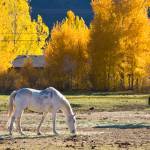Switching to Hay? Remember Vitamin E

As autumn shifts to winter, or summer droughts begin to set in, horse owners in many climates must provide horses with an appropriate alternative forage to fulfill fiber requirements. In most cases, this involves the use of hay, haylage, or hay cubes.
During the transition to winter, pasture grasses often turn brown and unpalatable, at which time growth is almost assuredly arrested. Horses will snack on these remnants, but more nutritious forage should be offered.
Owners ought to offer hay as soon as they feel horses are not consuming sufficient pasture to meet daily forage requirement, which is about 1.5-2% of body weight daily. For a 15.2-hand, 1,100-lb horse, that would be 16.5-22 lbs. of hay each day. Keep in mind, though, that this amount will likely satisfy the horse’s complete forage requirement.
If the horse is still nibbling away at pasture much of the day, it might need only a portion of this. If the horse leaves hay in favor of pasture, then too much hay is probably being fed at the time. Requirements can be gauged through consumption.
One vitamin that is particularly deficient in diets composed of preserved forages such as hay is vitamin E, an important antioxidant in the horse’s immune arsenal. The most effective source of supplemental vitamin E is d-alpha-tocopherol or natural vitamin E. Nano-E is a natural-source vitamin E supplement that possesses a unique delivery action, nanodispersion, which allows the vitamin to hit target tissues more quickly than other vitamin E supplements. Nano-E is available worldwide.








